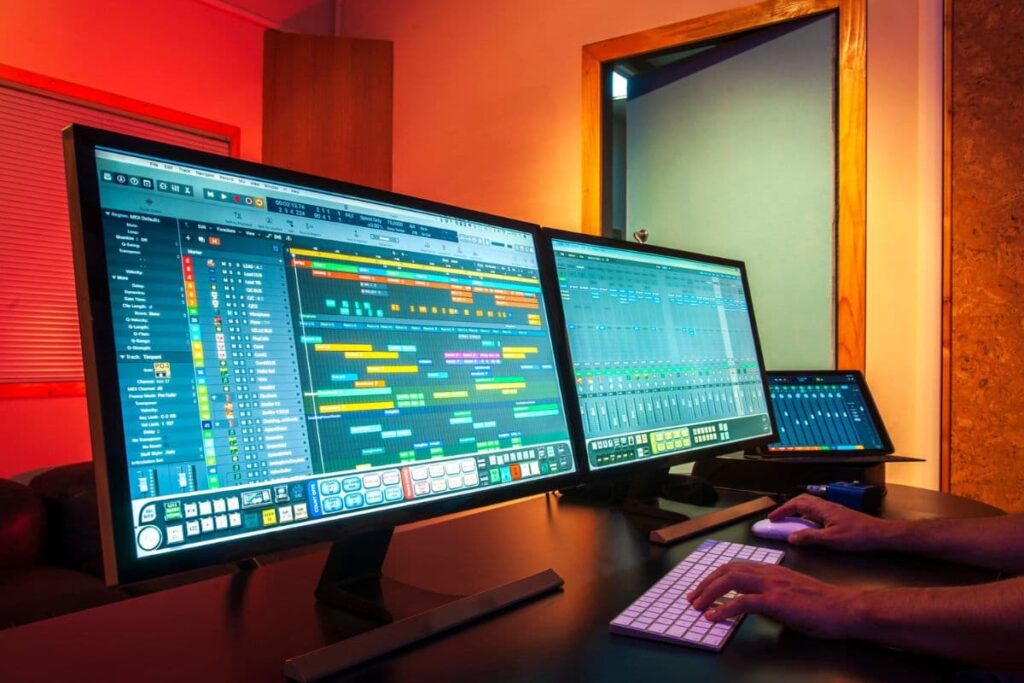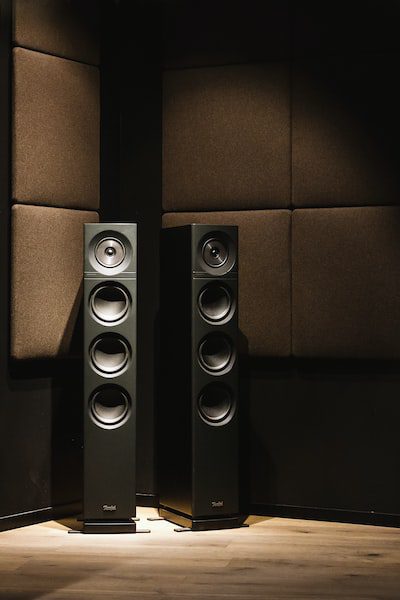When building your home recording studio, it is crucial to ensure all your equipment is set up correctly. Your monitors, in particular, need to be placed in the room correctly to get the best sound possible. So, should studio monitors be angled?
Studio monitors should be angled because the direction they face impacts the sound quality. Angling your studio monitors also helps you make a good music mix because it balances the different elements and keeps room acoustics from interfering.
This article will explain why and how most studio monitors should be angled. If you are creating a home studio and are curious to learn more about the proper positioning of monitors, read on!
Table of Contents
- How Should Studio Monitors Be Angled?
- Why Should Studio Monitors Be Angled?
- Final Thoughts on Studio Monitor Angles

How Should Studio Monitors Be Angled?
Before diving into why it is beneficial for studio monitors to be angled, it’s a good idea to explain how to set up your monitors properly for sound engineering.
If you fail to do this step, anything you produce will sound off, and fixing the problem will be more challenging.
While all studio rooms will be different depending on the available space, your monitors should be placed at least 12 inches (30.5 centimeters) away from the walls and sit at a 60-degree angle.
The monitors should be positioned to make an equilateral triangle with your body. The two monitors are the base of the triangle, and where you are seated is the tip. This studio setup will allow you to fully take in all of the sounds from each studio monitor and make any necessary adjustments.
Why Should Studio Monitors Be Angled?
Setting up your home studio so that all the equipment works well together can be challenging. Placing your studio monitors at an angle (whether mounted on the wall or on monitor stands) is essential to the process for several reasons.
I’ll discuss these reasons in detail below:
Angled Studio Monitors Have a Large Impact on Sound Waves
It is important to recognize that your sound will depend mainly on where your monitors are set up.
In fact, the monitor positioning and monitor placement have more power to change your sound negatively or positively than the monitors themselves do.
Studio Monitor Placement
Sound frequencies play a significant role in recording music, and when you are in a home studio you have built yourself, you must ensure that your monitors are angled off-axis correctly so that the sound is strong enough and you prevent standing waves from the rear wall.
The direction of your monitors will affect the higher frequencies in electronic music more than the lower frequencies.
This phenomenon happens because high frequencies are more directional and become louder when pointed at you.
As long as your monitors are angled, you can accurately hear the low and high frequencies, resulting in the best sound quality.
Angled Studio Monitors Balance Out Musical Elements

Part of getting a high-quality sound revolves around all the different musical elements that work together and do not overpower one another.
High quality can be achieved when you put both of your monitors at the same angle toward you.
If your monitors are not on an angle, certain aspects of the music may take over and create undesirable sound waves. Angled studio monitors allow the treble, bass frequencies, and other production elements to blend together to make the right sound.
Angled Studio Monitors Allow You To Position Yourself Correctly
As mentioned earlier in this article, your two monitors should make a triangle with where you are seated in the room. This setup will help you to hear everything perfectly equally and keep you from missing any pieces of your project that may be out of tune or out of sync.
Listening Position
The general rule when positioning your equipment is you should be seated approximately 38% away from the back wall of your space. As long as you are between 30-40% away, you will be in an optimal listening position to hear the music correctly.
The only way to make that perfect sound triangle is to have the monitors pointed toward your listening position at an angle.
Setting them up that way will let you sit in the right listening position and still hear everything you mix well.
Angled Studio Monitors Prevent Room Acoustics From Interfering
Depending on the size and style of room you have set up for your home recording studio and the distance from the front and rear walls, you could potentially have several issues with the room’s acoustics interfering with your music production.
Room Characteristics and Acoustic Treatment
Various factors could affect the resonance in your studio, including the following:
- The size and shape of the room.
- How many windows the room has?
- How tall is the ceiling of the room?
- Whether or not the room has carpet.
- Whether the room has acoustic treatment or acoustic panels.
In addition to all those possible interferences, the location of your monitors in the room will also impact how the music sounds.
Where your monitors are placed has the power to affect how the room resonates, and if they are not angled correctly, you could run into serious issues while producing.
Where your monitors are placed has the power to affect how the room resonates, and if they are not angled correctly, you could run into serious issues while producing.
If you find yourself having problems with resonance in your studio, changing the angle where the monitors are stationed can help to reduce the resonance levels.
Angled Studio Monitors Help You Make a Good Mix
Angling your studio monitors prevents sound frequencies, room resonance, and other potential home studio-specific issues from taking over your projects, helping you make a good music mix.
If you do not take the proper time to set up your monitors and they are positioned badly, the frequency response in your room is going to be wholly off-balance, and you will experience massive highs and lows in your mix that will be difficult to adjust after the fact.
Angled studio monitors help you build a listening environment where all of the sounds you create naturally balance out to make a well-balanced mix of music.
Final Thoughts on Studio Monitor Angles
While there are many crucial steps to take when creating a home recording studio, ensuring your studio monitors are angled is by far the most important.
Music is made up of sounds; if you cannot hear the sounds properly when putting them together, the music will not turn out as great as you would like.
- Review of the ALABS IRON MINI-WL: A Powerhouse Wireless Microphone - October 4, 2023
- What is a Saturator in Music Production: A Brief Explanation - May 11, 2023
- What Are Rotary DJ Mixers? An Overview - May 11, 2023
SoundStudiomagic.com is a participant in the Amazon Services LLC Associates Program, an affiliate advertising program designed to provide a means for sites to earn advertising fees by advertising and linking to Amazon.com. We also participate in other affiliate programs which compensate us for referring traffic.

